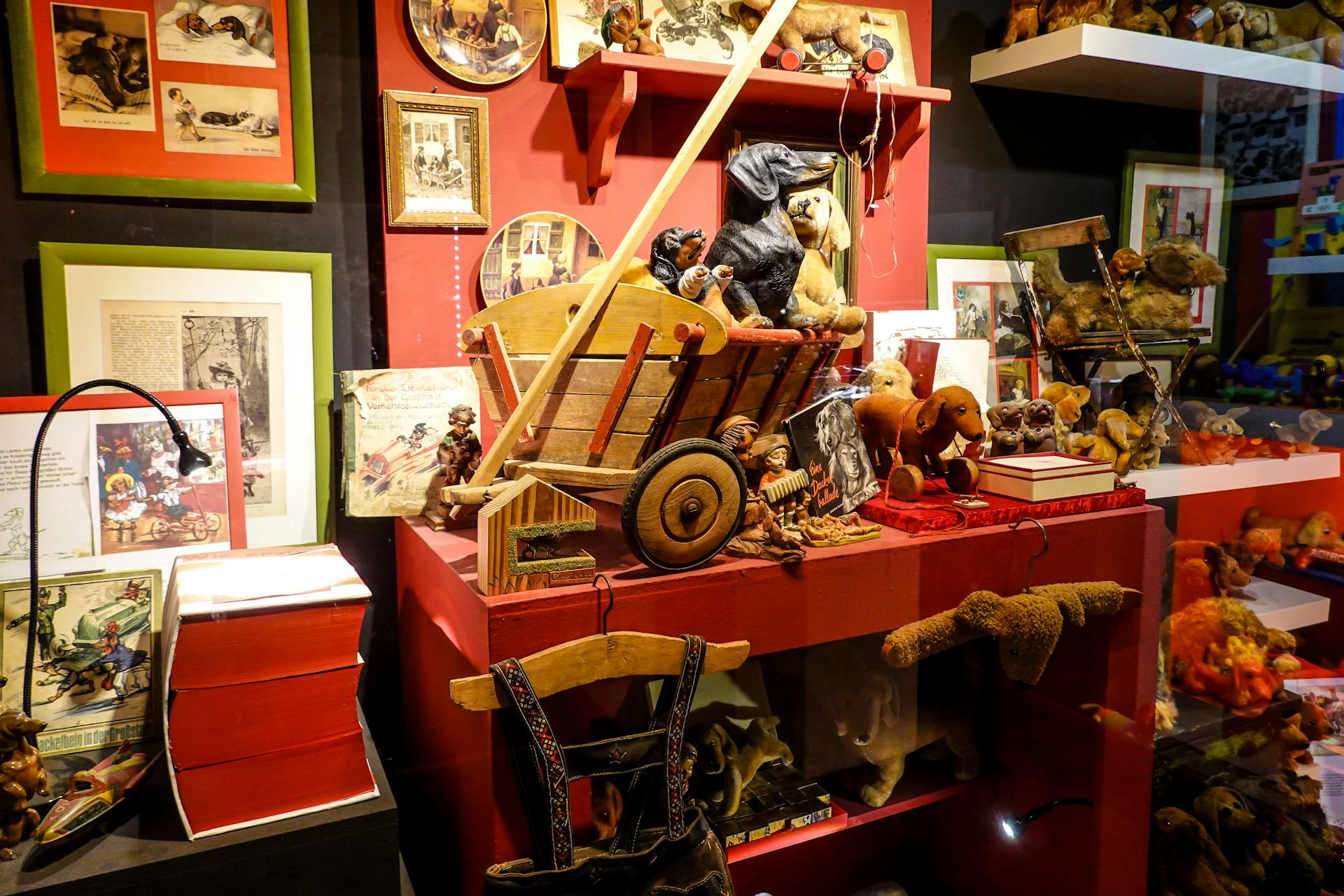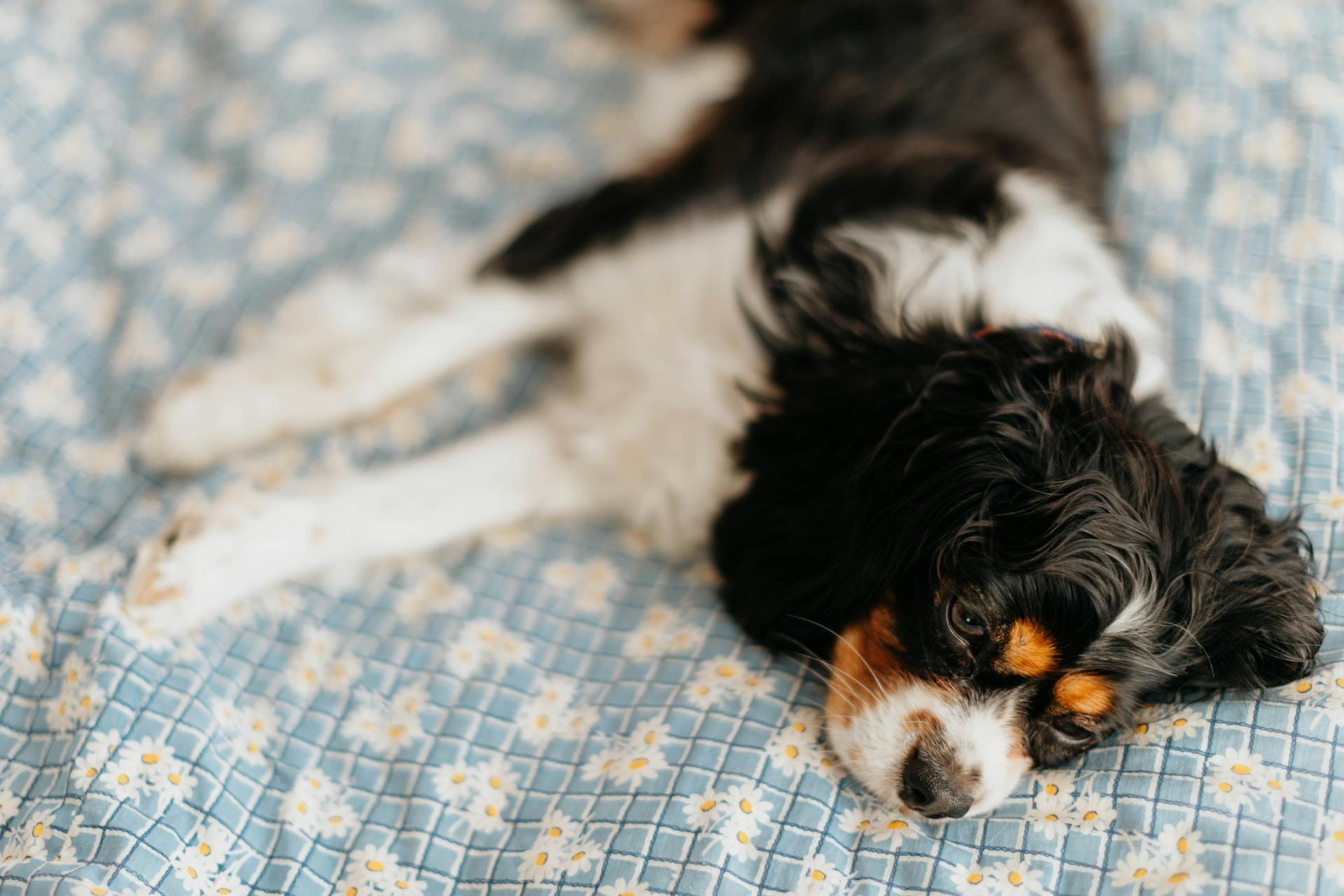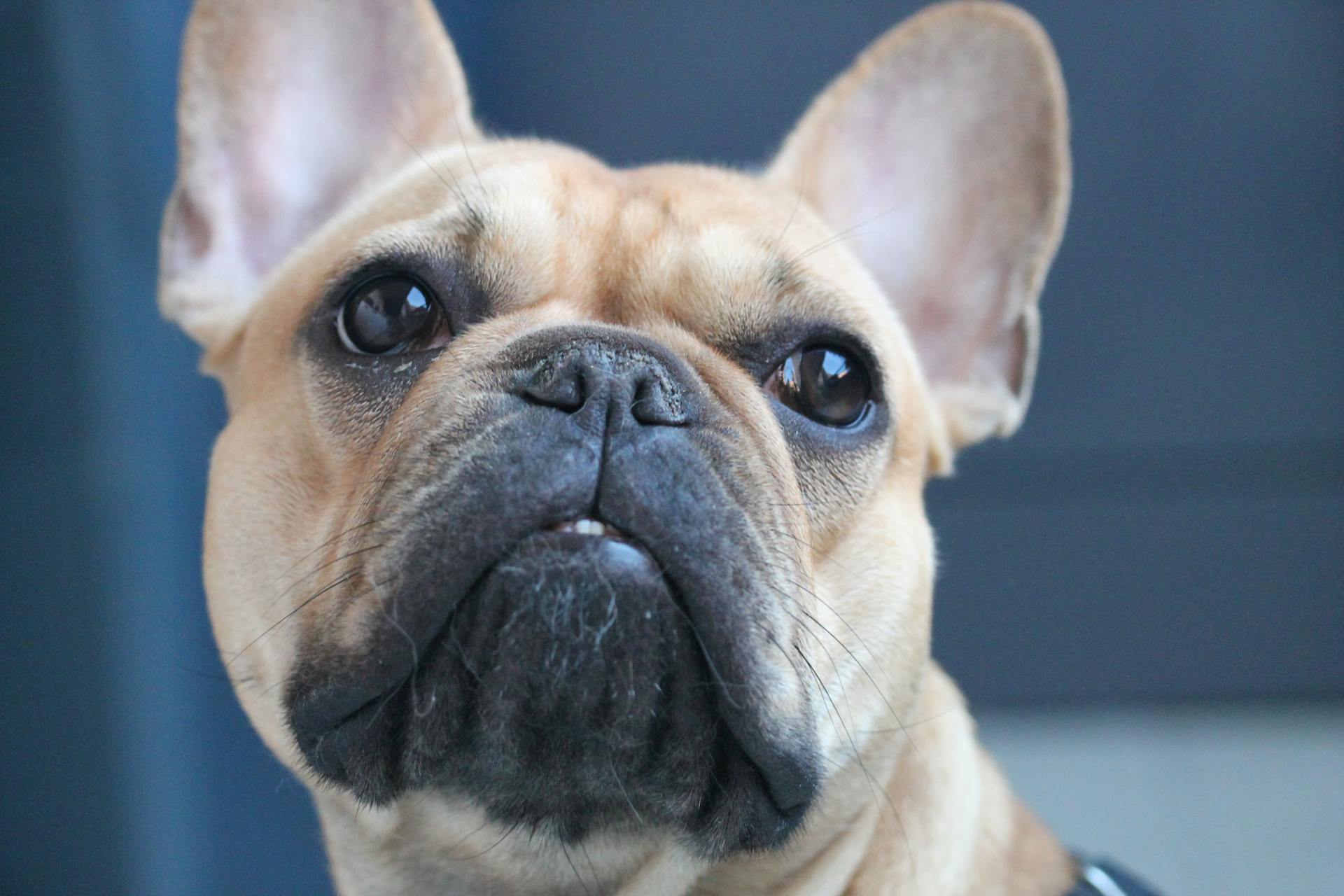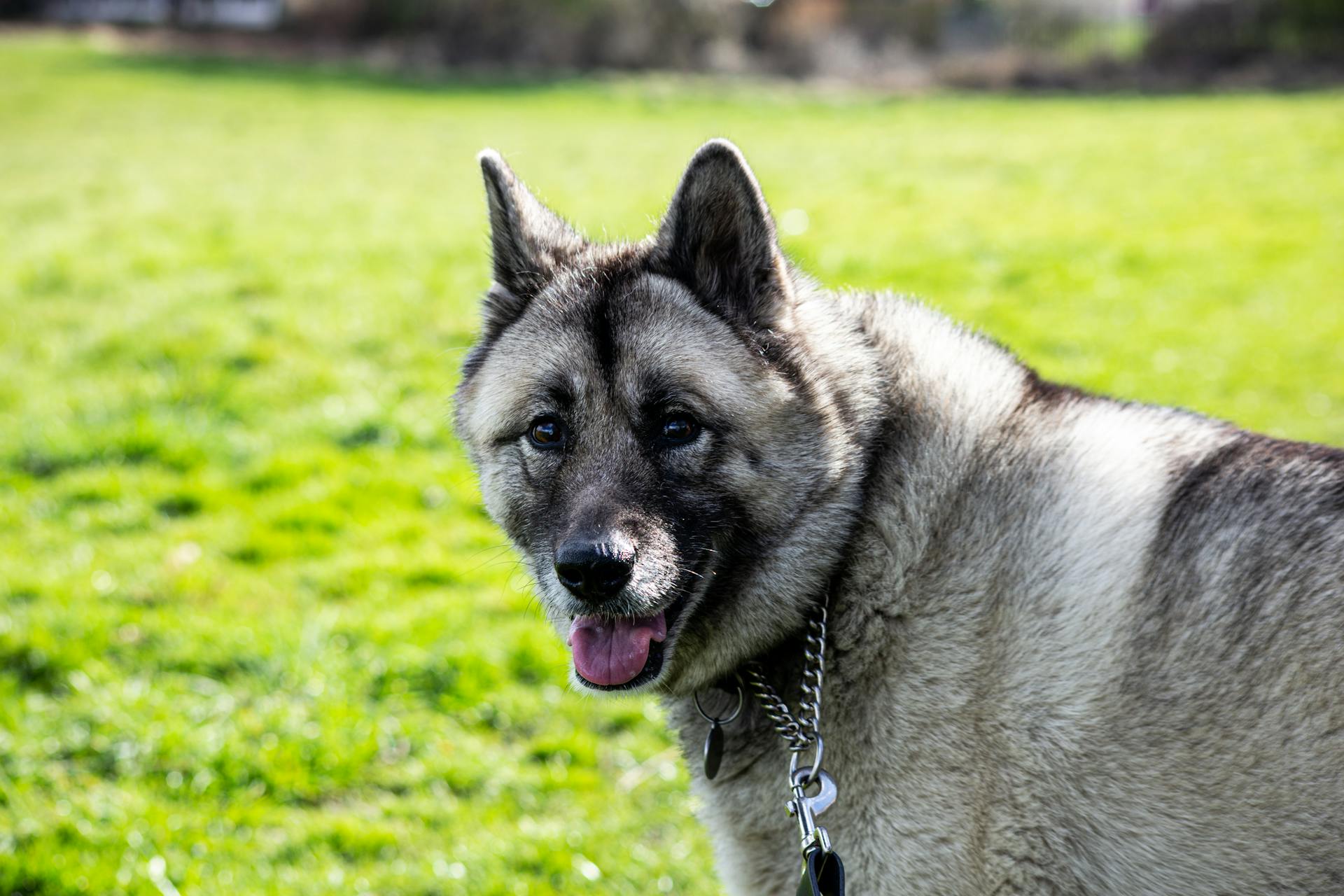
The Norwegian Elkhound is an ancient breed that's been around for thousands of years, with a rich history of hunting and companionship.
They're a medium-sized dog with a muscular build, typically weighing between 45-60 pounds.
One of the most distinctive features of the Norwegian Elkhound is its thick double coat, which sheds heavily and requires regular grooming.
The Norwegian Elkhound is an energetic breed that needs plenty of exercise to stay happy and healthy.
Additional reading: Dogs Breeds That Start with B
Physical Characteristics
The Norwegian Elkhound is a medium-sized dog, averaging 20.5 inches in height and weighing between 48 to 55 pounds. They have a sturdy build, with strong and compact legs that allow them to move easily in various types of terrain.
Their wedge-shaped head tapers to a long black snout, and their intense dark brown eyes are oval-shaped and keen. They have a distinctive harness mark, a band of longer guard hairs from shoulder to elbow, and their muzzles are black and get lighter over their heads.
Their thick double coat is weather-resistant, with a coarse topcoat and a downy undercoat that provides ample protection against harsh winds and helps them dry quickly after a cool water dip. They shed twice a year in the spring and fall, but require only weekly brushing, possibly more when shedding.
Appearance
The Norwegian Elkhound's appearance is quite striking. They have a thick double coat that sheds twice a year, so be prepared for some extra grooming during those times.
Their ears are one of their most distinctive features - pointed and erect, although they may relax when the dog is calm. Their medium-oval eyes are dark brown, and their black, slender muzzles are tapered with a blunt nose.
Norwegian Elkhounds come in various combinations and shades of gray, black, and silver with dark markings. They have a smooth-laying double coat with long outer hair and a soft undercoat.
Their tails are full and curl tightly over their backs, and they have a distinctive harness mark - a band of longer guard hairs from shoulder to elbow. They're built for action, with strong, compact legs that allow them to scale various types of terrain with ease.
Here are some key physical characteristics of the Norwegian Elkhound:
- Weight: 48-55 pounds
- Height: 20 inches at the shoulder
- Coat: Thick double coat with long outer hair and a soft undercoat
- Color: Various combinations and shades of gray, black, and silver with dark markings
- Tail: Full and curl tightly over the back
Size
The Norwegian Elkhound is a medium-sized dog, averaging 20.5 inches in height. Males average 55 pounds, while females weigh around 48 pounds.
Their height at the shoulder typically ranges from 19.5 to 20.5 inches.
Here's a quick rundown of the breed's size:
- Height: 19.5 to 20.5 inches at the shoulder
- Weight: 48 to 55 pounds
Breed Characteristics
The Norwegian Elkhound is a sturdy breed built for rugged terrain and cold climates, with a height of 19.5 to 20.5 inches at the shoulder and a weight of 48 to 55 pounds.
They have a distinctive wolf-like appearance, with a curled tail, erect ears, and a dense, silver-gray coat.
This breed sheds a lot of hair, requiring daily brushing during spring and fall shedding seasons to keep excess hair under control.
With regular exercise and mental stimulation, Norwegian Elkhounds can thrive in active households. They need daily exercise that will challenge them physically and mentally, with a recommended 20 to 30 minutes of exercise twice a day.
Take a look at this: Puli Dog Short Hair
Their high energy level and strong prey drive make them a great fit for families who enjoy outdoor activities and have a large yard to run around in.
Here's a breakdown of the breed characteristics:
Their high intelligence and trainability make them responsive to positive reinforcement techniques, such as play, praise, and food rewards. However, they can be independent thinkers and require consistent training and socialization.
Temperament and Personality
The Norwegian Elkhound's temperament is a unique blend of loving attention and sharp mental agility. They're loyal, patient with children and other dogs, and have a playful sense of humor.
They're very people-oriented and consider themselves to be an equal member of the family whose ideas should be valued. You'll receive intense eye contact with this breed.
Norwegian Elkhounds are independent thinkers and need to know you're the leader of the pack. They can be hard to train because of that independence, but they can get it if you're firm and consistent.
They're naturally protective, if not outright possessive, of their family. They'll sound the alarm if they sense any potential danger, so be prepared for some vocal feedback.
They're highly intelligent dogs that get bored easily, especially once they think they've mastered something. Consistent and fair training with plenty of treats and positive reinforcement is the way to go.
With proper training, they can excel in various activities like nose work, dock diving, and other task-oriented jobs. They'll thrive on the challenge and interaction with you.
However, they can be possessive of their family's attention and may not always seek out new friends. They'll generally come around to strangers, but it may take some time.
Early socialization is crucial for a well-rounded Norwegian Elkhound. Enroll them in puppy kindergarten and expose them to various people, sights, and experiences to help them polish their social skills.
They're naturally curious and love to explore, so be prepared for some wanderlust. Keep them on a leash unless in an enclosed area or you're tracking game and they respond well to recall.
Consider reading: Crate Training Pros and Cons
Care and Maintenance
They're a high-energy breed that needs 30 minutes of exercise twice a day to burn off energy and maintain a healthy weight.
Daily brushing is a must for Norwegian Elkhounds, and they shed their undercoat twice a year, so be prepared for some extra vacuuming.
Their thick double coat requires regular grooming, including brushing in the opposite direction to remove loose hair, trimming their nails, and checking their ears weekly.
You'll also need to brush their teeth regularly, as they won't remind you to do so.
Shedding can be intense, especially during the spring and fall, but shaving them is a big no-no, as it can disrupt their body temperature regulation and hair growth.
If this caught your attention, see: Do Hypoallergenic Dogs Have Hair or Fur
How to Care for
Norwegian Elkhounds require daily exercise, with breeders recommending 30 minutes of activity twice a day to keep them physically and mentally healthy.
They're exceptionally food-motivated, so be prepared to keep an eye on their diet to prevent obesity. A home with a fenced yard is ideal, but they can adapt to apartments if you're willing to provide regular exercise and attention.

Daily brushing is a must for this double-coated breed, with a focus on removing loose hair in the opposite direction to keep them looking their best. You'll need to brush, lint roll, and vacuum more frequently during shedding season, which occurs twice a year.
Norwegian Elkhounds are people dogs and thrive on attention, so be prepared to spend quality time with them. Crate training is beneficial, but it's essential to use it responsibly and not as a form of punishment.
With regular grooming, including nail trimming, ear checks, and brushing their teeth, you can keep your Norwegian Elkhound looking and feeling great. Just remember to avoid shaving their coat, as it can disrupt their body temperature regulation and lead to health issues.
Diet
Your Norwegian elkhound needs a balanced diet to stay healthy. Always feed a quality, nutritionally balanced canine diet.
Fresh water should be available at all times, so make sure your dog always has access to it.
It's typical to feed two measured meals per day, but you should check with your vet to determine the best feeding schedule for your dog.
Norwegian elkhounds are known to love food and will often beg for extra, so be sure to monitor their daily intake to prevent overeating.
Training and Environment
Training your Norwegian Elkhound requires patience, as they can be strong-willed and independent. Consistency is key, so work on obedience every day and don't switch commands up.
Socialization is crucial, especially for this friendly breed. Start socializing your dog while they're a puppy, take them on walks to meet new people and animals, and enroll them in puppy preschool to help them learn to play nicely with others.
Norwegian Elkhounds can adapt to various living environments, but they need regular exercise and mental stimulation to prevent boredom and mischief. A fenced-in yard is ideal, but it's not enough activity for them - they need to go on longer walks and engage in energetic activities like flyball or Frisbee.
They are good with kids and can thrive in an active family, but apartment living can be a challenge if you don't have time to ensure they get enough exercise. They are prone to barking and howling, so it's essential to keep outdoor activity to cooler parts of the day when it's hot out.
See what others are reading: National American Eskimo Day
Children and Pets
If you're introducing a Norwegian Elkhound into a household with children, it's essential to establish clear boundaries and rules for interactions between dogs and kids. Elkhounds are excellent with children and will play with and protect them.
Supervise any interactions between dogs and young children to prevent biting or ear or tail pulling. Teach your child never to approach any dog while he’s eating or sleeping, or to try to take the dog’s food away.
The key is to teach children how to approach and touch dogs gently and respectfully. This will help prevent any accidents and ensure a harmonious household.
Environment
A Norwegian elkhound can adapt to a variety of living environments, but they do require a lot of exercise and mental stimulation to prevent boredom and destructive behavior.
They thrive in cold climates, but can also live in warm places, as long as you take precautions to keep them cool in hot weather.
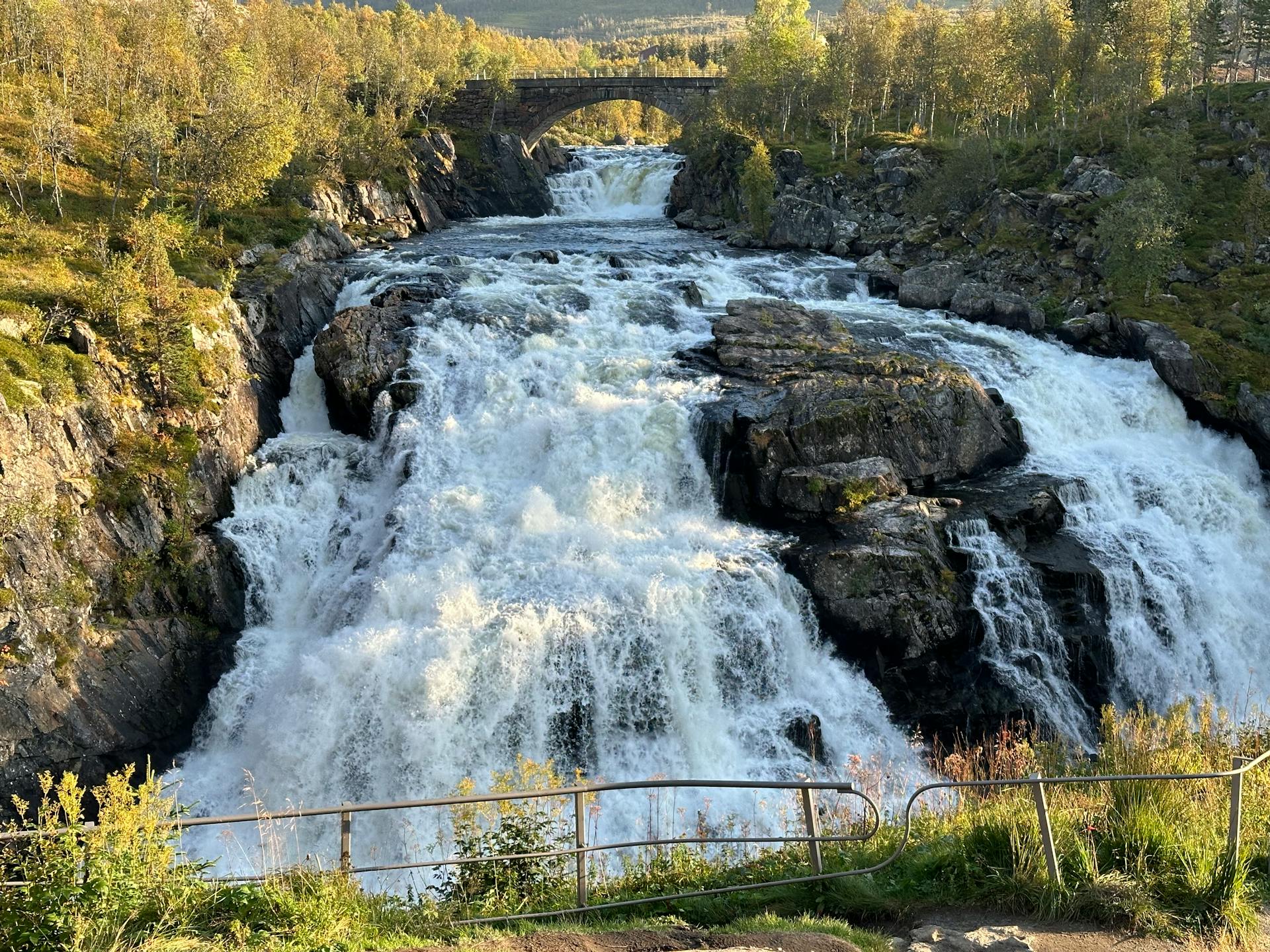
A fenced-in yard is ideal, but it's not enough to keep an elkhound happy - they need to be able to trot and hike for hours.
Daily visits to a dog park or engaging in energetic activities like flyball or Frisbee can help with socialization and burn off excess energy.
Norwegian elkhounds are good with kids and do best in an active family, but they can be prone to barking and howling if they don't get enough exercise.
If you live in an apartment or small space, it's essential to ensure your elkhound gets at least one to two hours of exercise per day, and provide plenty of mental stimulation to prevent boredom.
In hot weather, it's best to keep outdoor exercise brief and ensure your elkhound has access to plenty of fresh, cool water.
Training
Training a Norwegian Elkhound requires patience, as they can be challenging to train due to their intelligence and independent nature.
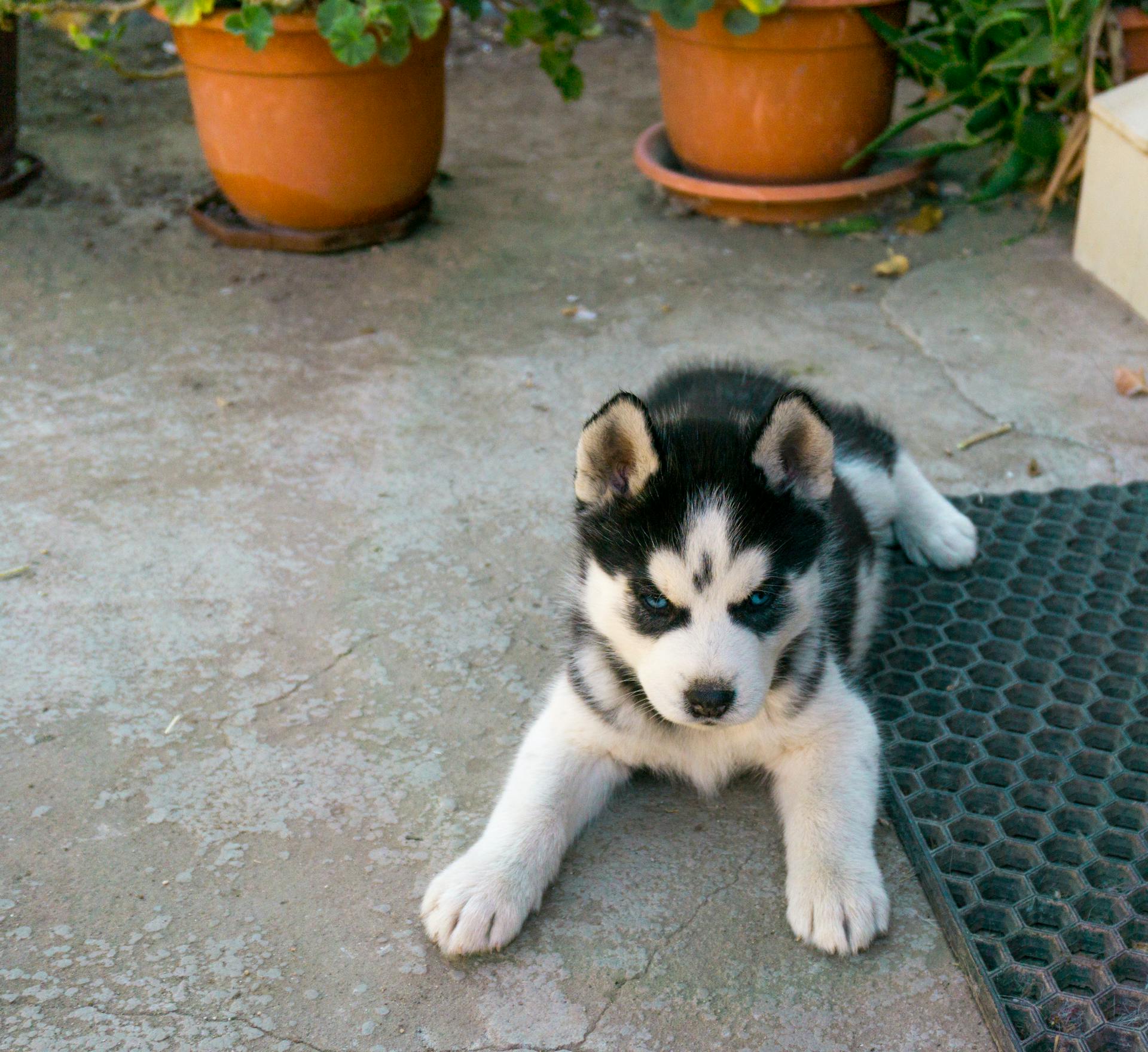
Start with the basics like sit, stay, come, and leash walking, as Elkhounds are eager to learn as long as it's not routine.
Positive reinforcement training methods are a great way to keep training fun, using treats, toys, or praise to reward good behavior.
Consistency is key, so work on obedience every day and avoid switching up commands.
Training should be a two-way street, where you and your Elkhound learn together, but be aware that inexperienced pet parents may find themselves being trained rather than the other way around.
Socialization is crucial, even for this naturally friendly breed, so start socializing your dog while they're a puppy and take them on walks to meet new people and experiences.
Suggestion: Pembroke Welsh Corgi Training
Health and History
The Norwegian Elkhound is a breed with a rich history, dating back thousands of years to the Viking era. They've been used for guarding, herding, and hunting, and have even been a common fixture in Norwegian culture.
One of the most significant health concerns for Elkhounds is Progressive Retinal Atrophy (PRA), which can cause blindness. This condition can affect dogs as young as 6 weeks old and can lead to complete loss of vision by 12-18 months of age.
Elkhounds are also prone to hip dysplasia, a genetic skeletal condition that can cause painful osteoarthritis. Hip dysplasia can be diagnosed in younger dogs, and surgery may be an option to alleviate the condition.
To ensure your Elkhound stays healthy, it's essential to feed them appropriately, as they can rapidly gain weight. You can tell if your dog is getting a bit chonky if you see their sides or back rippling as they run.
Here are some common health concerns to be aware of in Elkhounds:
- Fanconi Syndrome: a serious, inherited disease that affects the kidneys and can lead to excessive urination and thirst.
- Hypothyroidism: a disorder of the thyroid gland that can cause conditions such as epilepsy, hair loss, and skin problems.
- Progressive Retinal Atrophy (PRA): a family of eye diseases that can cause blindness.
- Sebaceous Cysts: follicular cysts that can form under the dog's skin and may require surgical removal.
Overall, Elkhounds are a relatively healthy breed with a long lifespan of 12-15 years.
Health
Norwegian Elkhounds are generally a healthy breed, but like all breeds, they can be prone to certain health issues.
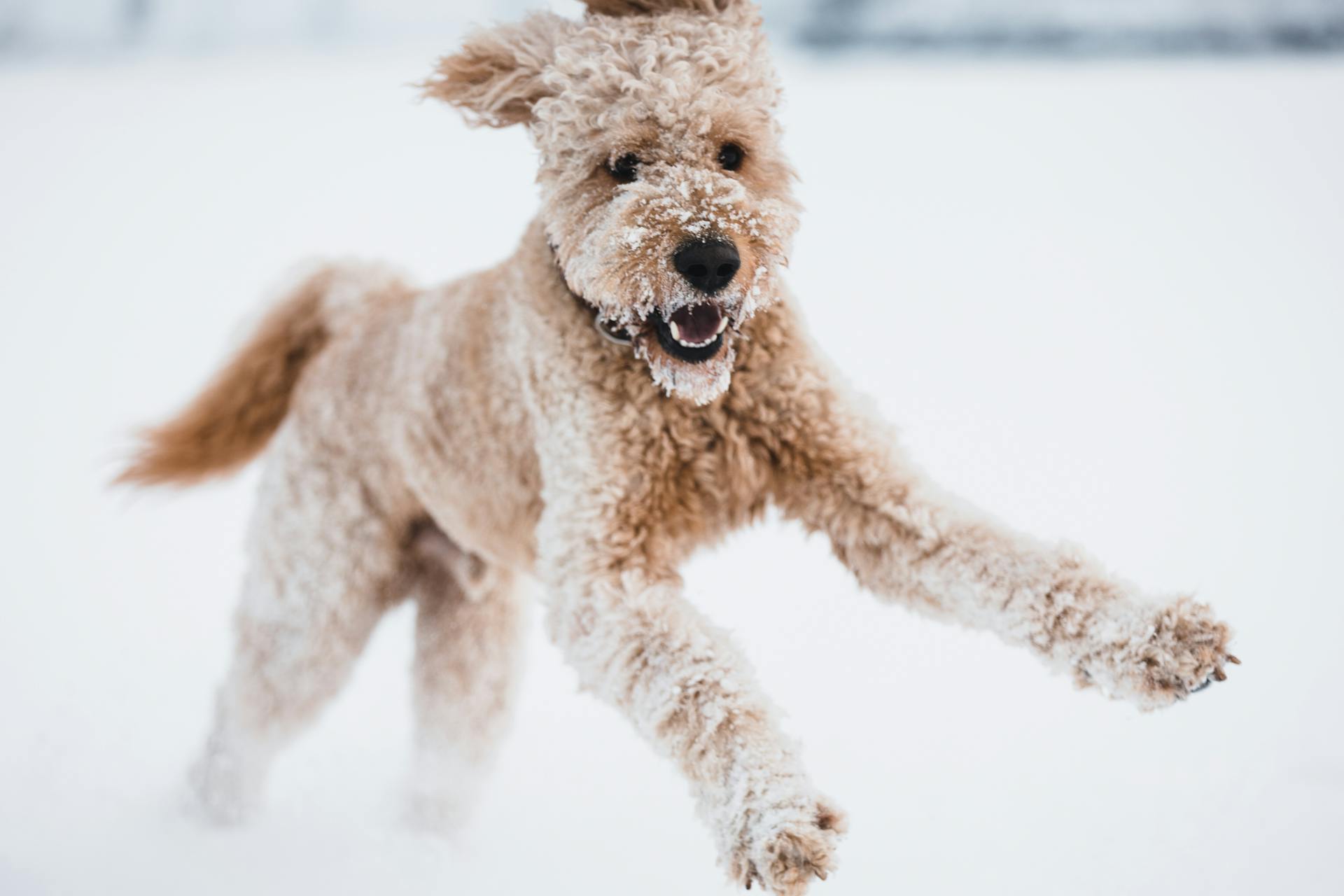
Their life expectancy is 12 to 15 years, which is a relatively long lifespan for a dog.
Hip dysplasia is a common problem in large breeds, including Norwegian Elkhounds, and can cause pain and lameness in the back legs.
Hip dysplasia is a condition in which the hip joint isn't formed properly and rubs, causing the dog pain.
Genetic eye conditions, such as progressive retinal atrophy (PRA), glaucoma, and cataracts, can also affect Norwegian Elkhounds and lead to blindness.
If your pup has any issues with their eyes, such as redness, cloudiness, squinting, bulging, running into things, or pain, please see your veterinarian right away.
Fanconi syndrome is a serious, inherited disease that affects the kidneys and can lead to improper levels of calcium, glucose, phosphate, sodium, and amino acids.
Symptoms of Fanconi syndrome include excessive urination and thirst, weight loss, muscle wasting, muscle pain, lethargy, loss of appetite, and vomiting.
Hypothyroidism is a disorder of the thyroid gland and can cause conditions such as epilepsy, alopecia (hair loss), obesity, lethargy, hyperpigmentation, pyoderma, and other skin conditions.

Progressive retinal atrophy (PRA) is a family of eye diseases that involves the gradual deterioration of the retina and can cause blindness.
Sebaceous cysts are follicular cysts that form under the dog's skin and can range in size from small to as large as a walnut.
If you're acquiring a Norwegian Elkhound from a breeder, it's essential to do plenty of pedigree research to ensure you're getting a healthy pup.
Here are some common health issues to be aware of:
- Hip dysplasia
- Progressive retinal atrophy (PRA)
- Sebaceous cysts
- Fanconi syndrome
- Hypothyroidism
The History
The Norwegian Elkhound has a rich history that spans thousands of years, with some estimates suggesting it dates back as far as 5000 BCE.
The breed originated in Norway, where it was used by the Vikings to guard and hunt. It's fascinating to think about the role these dogs played in the lives of our ancestors.
The Norwegian Elkhound was used to guard herds, flocks, and homes, as well as to hunt large game such as bear and moose. Its ability to track and hold prey at bay made it a valuable asset to hunters.
Related reading: Caucasian Ovcharka Guard Dog
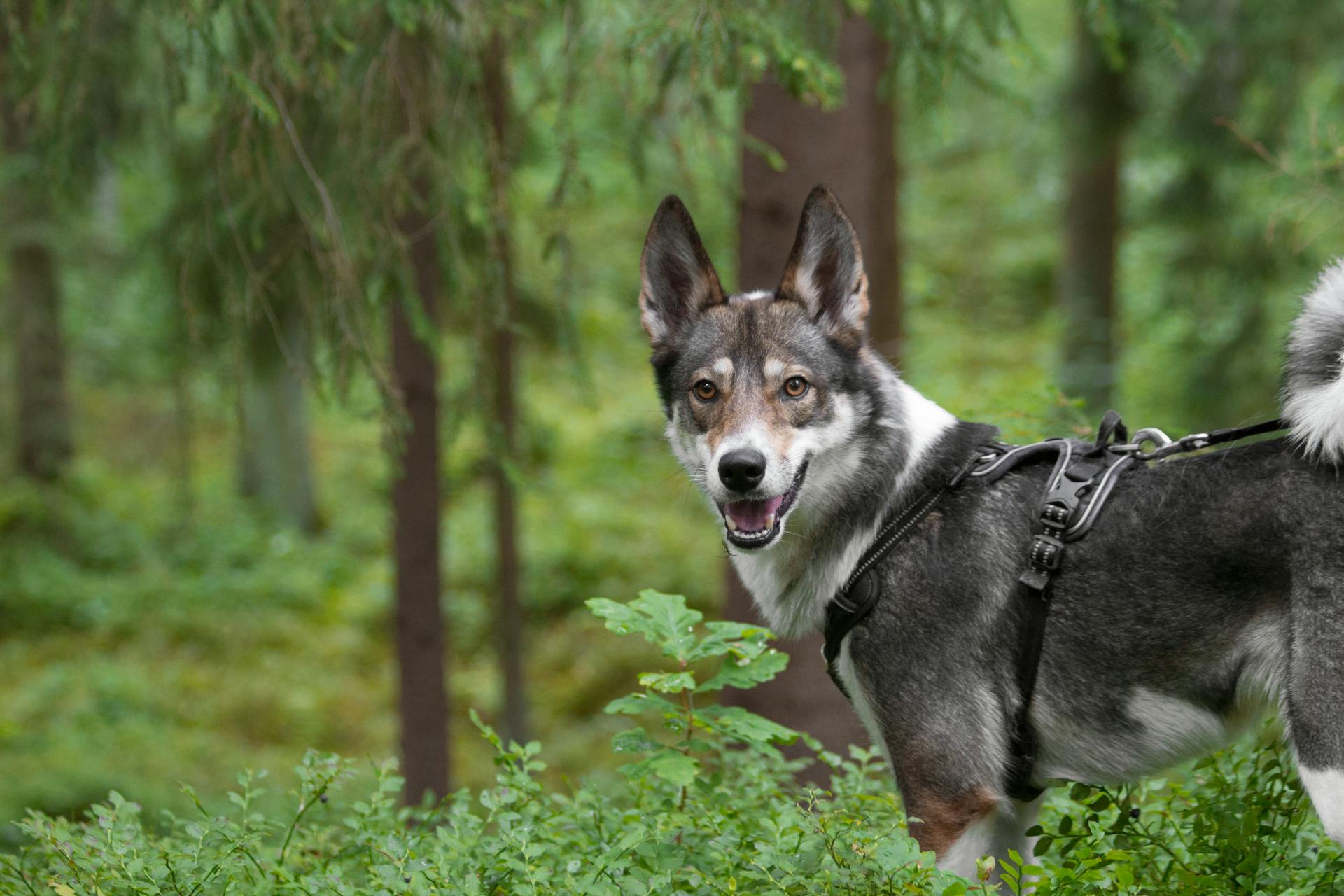
In 1877, the Norwegian Hunters Association held its first dog show, which sparked a renewed interest in the breed and led to efforts to create a breed standard and records. This marked the beginning of the Norwegian Elkhound's journey as a distinct breed.
The breed has undergone significant changes over the years, but its core characteristics have remained the same. Today, the Norwegian Elkhound is recognized by the American Kennel Club and ranks 106th among registered breeds.
The Norwegian Elkhound's versatility is impressive, with the breed excelling in various dog sports and careers, including conformation, agility, obedience, and tracking. Its intelligence and athleticism make it a popular choice for active families.
Breed Details
The Norwegian Elkhound is a sturdy breed with a distinct appearance. The height of a Norwegian Elkhound typically ranges from 19.5 to 20.5 inches at the shoulder.
This breed's weight is also notable, ranging from 48 to 55 pounds.
Breed Details
The Norwegian Elkhound is a medium-sized breed with a muscular build. They typically stand between 19.5 to 20.5 inches at the shoulder.
Their weight range is between 48 to 55 pounds, making them a sturdy companion.
Their height and weight can vary slightly between males and females, with males being slightly taller and heavier than females.
Here's a quick reference guide to their size:
Elkhound
The Norwegian Elkhound is a medium-sized dog with a rugged and beautiful appearance. They typically stand between 19 to 20 inches tall and weigh between 48 to 55 pounds.
These dogs are highly intelligent and have a high energy level, making them perfect for active families or individuals who enjoy outdoor activities like hiking and swimming. They are also cold weather tolerant and love water.
One of the best things about Norwegian Elkhounds is their loyalty and affection towards their families. They are great with children and make wonderful family dogs with very maternal instincts.
However, they can be a bit stubborn about training, so consistent and patient training is a must. They are also prone to shedding, especially during seasonal changes.
Here are some key characteristics of the Norwegian Elkhound breed:
Overall, the Norwegian Elkhound is a loyal, intelligent, and active breed that makes a great companion for outdoor enthusiasts and families alike.
Featured Images: pexels.com
